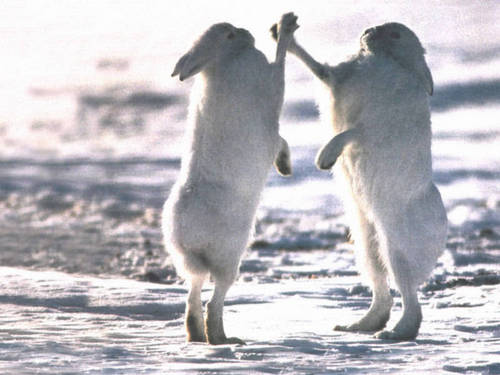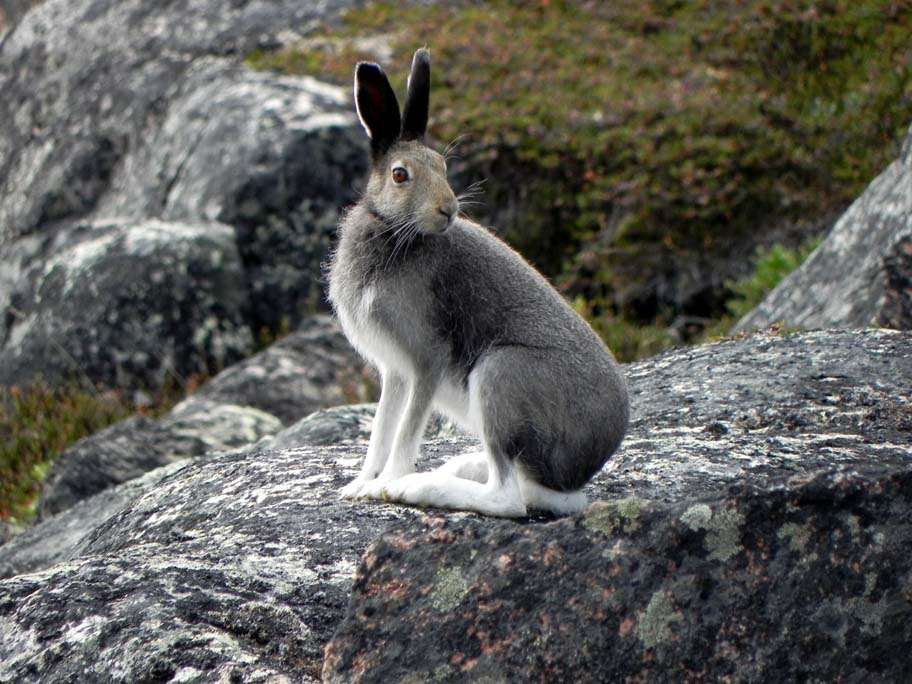Wow those are great photos. I found some a few months ago and I love how their coats change for the season. About the standing are they fighting? They don't really look like it? But I know Chica stands like that when she wants to knock the crap out of her brother for taking food... and if I were them I would make like a greyhound, get on a bus and go for Miami! Dig into the snow to keep warm!!! Oh my gosh!!!!
This is what I found on Nat Geo:
Fast Facts
Type:
Mammal
Diet:
Omnivore
Average life span in the wild:
Head and body, 19 to 26 in (48 to 67 cm); Tail, 1 to 3 in (3 to 8 cm)
Weight:
6 to 15 lbs (3 to 7 kg)
Size relative to a 6-ft (2-m) man:
The arctic hare lives in the harsh environment of the North American tundra. These hares do not hibernate, but survive the dangerous cold with a number of behavioral and physiological adaptations. They sport thick fur and enjoy a low surface area to volume ratio that conserves body heat, most evident in their shortened ears. These hares sometimes dig shelters in snow and huddle together to share warmth.
Hares are a bit larger than rabbits, and they typically have taller hind legs and longer ears. Like other hares and rabbits, Arctic hares are fast and can bound at speeds of up to 40 miles (60 kilometers) an hour. In winter, they sport a brilliant white coat that provides excellent camouflage in the land of ice and snow. In spring, the hare's colors change to blue-gray in approximation of local rocks and vegetation.
Arctic hares are sometimes loners but they can also be found in groups of dozens, hundreds, or even thousands of individuals. Unlike many mammals, arctic hare groups disperse rather than form during mating season. Animals pair off and define mating territories, though a male may take more than one female partner.
Females give birth to one litter per year, in spring or early summer. Two to eight young hares grow quickly and by September resemble their parents. They will be ready to breed the following year.
Food can be scarce in the Arctic, but the hares survive by eating woody plants, mosses, and lichens which they may dig through the snow to find in winter. In other seasons they eat buds, berries, leaves, roots, and bark.
Traditionally, the arctic hare has been important to Native Americans. These fairly plentiful animals are hunted as a food resource and for their fur, which is used to make clothing.
Ok I'm a Native American and our tribe ain't never used no Rabbit for nothing.. but we are Southereastern Indians...
not artic.. but still I would have MOVED along time ago if my family was originally from the artic circle.. trust me..
I would have found a map and went SOUTH!
NOW I found some great photos of the Hares with their brown coats in Dengali park from this persons road trip photos.
http://www.serenitysys.com/photogallery/alaska_2009/index_leg_09.html
You have to scroll down halfway to the page and see the photos of the Brown Artic Hares and they are great photos!!!
Vanessa









